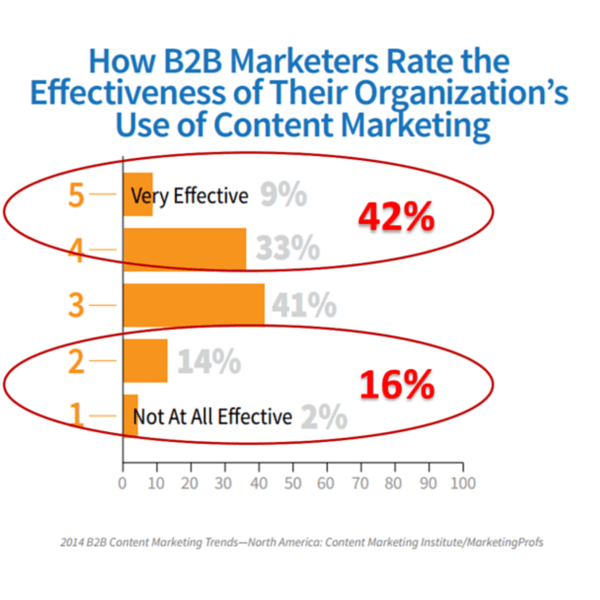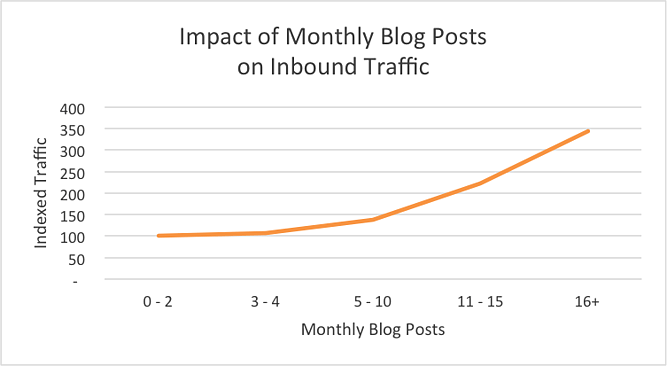According to a report by Brightcove, 93% of B2B marketers in North America use content marketing to generates leads and sales. With content marketing costing 62% less than traditional marketing tactics and generating 3x as many leads, most people aren’t surprised that content marketing has become the route to go.
Yet despite its popularity, only 42% of content marketers believe they are effective at content marketing.

(Image Source)
Here are some common content marketing mistakes that companies are making and how to avoid them:
Not Knowing Your Audience
One problem that novice content marketers face is not knowing their audience. beyond that, you would be shocked by how many businesses, in general, don’t know their audiences. Taking the time to create a customer profile can help marketers properly target the right audience with their content.
Unfortunately, many businesses skip this step and just start creating content which can lead to businesses attracting leads that will never purchase.
Don’t guess at what type of content your audience wants. Instead, listen to your customers and get feedback on the types of problems they face in their business.
Creating content targeted towards your ideal customer will attract other customers like them as that content gets shared on social media or as it starts to drive traffic through SEO or other channels. Take the time to define who you are writing for and what type of content your ideal customer expects. This way you can attract the right audience.
Creating The Wrong Content
Some businesses are overly focused on creating keyword-targeted content for SEO purposes. Perhaps they noticed some of their articles ranked for certain keywords and were bringing in search traffic, so they decided to focus only on SEO.
Doing only keyword-targeted content usually does not result in a good user experience. Human readers will be unlikely to follow your blog because instead of targeting reader interests, your blog is throwing out keyword-targeted content for the search engines.
Evergreen keyword-targeted content can also be boring as the highest volume search phrases have already been written about by numerous other websites. In other words, most blogs that are only focused on SEO are rehashing the same ideas other people have already written about.
Don’t create low-quality content just to rank for keywords. Low-quality content can backfire and discourage other people from sharing your content or following you.
SEO is important for content marketing, but be sure that you are still creating interesting and useful content to attract new readers to your blog. Even if SEO is a priority, not everything you write has to be SEO focused.
Not Optimizing For SEO
While creating content just for SEO purposes is a mistake, marketers should also refrain from ignoring SEO completely. Search engines can drive continuous traffic to your site and the more content you create, the more traffic can increase.
Do some keyword research before you publish each article so that you can insert keywords into the title and meta tags. Look for similar articles that other people have written and look for potential keywords you can target.
Ideally, your article should contain a mix of content designed to engage your audience and other thought leaders in your niche, plus, designed to rank in the search engines. Having a mix of SEO targeted content and engagement-focused content will allow you to increase website traffic as well as build an audience that is interested in what you say.
Not Promoting Content
Another common mistake businesses make is not promoting their content. Having a strong content creation plan is only half the game. If you don’t promote your content your target audience will never find it.
Marketers need to develop a strong content promotion plan so they can systematically let people know about their articles. A good promotion plan typically includes a link building, guest posting, or social media plan to get other influencers to share your articles.
To maximize your reach, consider promoting your content in multiple channels or even repurposing it. Look for communities and social media sites where you can share your content.
Build relationships with influencers by sharing their content and mentioning them in your articles. Participate in communities to get your name out there by visiting and contributing regularly to online groups and forums.
You should also consider using email outreach to share your content, along with even paid ads. You can always adjust your content marketing plan as you move forward, but be sure you at least have a plan in place when you start out.
Expecting Results Too Quickly
Many businesses like seeing fast results and one mistake marketers make when getting into content marketing is expecting results too quickly.
So how long should content marketing take before results are seen?
Joe Pulizzi is the founder of Content Marketing Institute and he says in his book Content Inc that business should invest 15-17 months of consistent content creation before seeing results or expecting to generate significant revenue from their content marketing operation.
A blogging study by Hubspot revealed that companies that published 400 or more blog posts got twice as much traffic as companies that published between 300 and 400 blog posts.

(Image Source)
But businesses that do a good job with content creation and commit to it long term will see the best results. As the number of articles on your site increases, your content will rank for more search terms, attract more links and social shares, and website traffic will start to accelerate.
Selling Too Much
Many businesses get into content marketing with the goal of generating leads and sales from their content. However, some businesses may discover that their content does not directly generate new leads or sales.
To rectify the issue, some businesses will insert a sales pitch or incorporate their product into every piece of content they write.
While adding a call to action into your content can make sense in certain circumstances, some businesses make the mistake of selling too much in their content. Mentioning your company in every single blog post makes readers question your authenticity.
Readers are more likely to follow a blog or read content from sources they feel are genuinely providing the best-unbiased information. When marketers sell too much in their content, the reader becomes skeptical about the information.
Instead of selling in every article, try to limit sales pitches to bottom of the funnel articles where people are more likely to convert. Or test out adding a call to action to a few relevant articles that get a lot of traffic each month.
For content marketing to be effective, don’t forget to put your reader first before your company’s interests. You don’t have to ignore your own goals, but be cautious about being too salesy if you want to grow your following.
Blindly Following Generic Content Marketing Advice
Don’t make the mistake of blindly “following the herd.”
For example, if you look at job listings for content writers, you’ll see lots of job descriptions that require writers to write only really long articles that are 2,000+ words. The belief that you have to use long-form content to be competitive comes from various studies that show that long-form content gets better search engine rankings than shorter content.
However, a short-form content strategy can also be quite effective. According to SimilarWeb, Entrepreneur.com is in the top 5,000 highest sites in terms of traffic and got around 14 million visits in the past 6 months.

However, on their contributor’s guidelines page, they mention that they want short articles no longer than 1,200 words.
To win at content marketing, you have to be able to make your own judgments about what works and what doesn’t. People who become thought leaders do so because they are able to form their own opinions and be creative instead of just following what everyone else is doing or saying.
If a marketing blog says that something is true, always look for examples where someone did the opposite and still succeeded. There are few rules in marketing that can’t be bent or broken, so be open-minded when developing your own content marketing plan.
Ignoring Or Disabling Blog Comments
Businesses disable comments on their blogs for several reasons.
One of the main reasons is that moderating and replying to comments can take a ton of time, especially as your blog gains a significant following. Taking time to reply to comments takes away time you could be spending creating more content or doing other things to grow the business.
Another reason is that as a blog grows, spam comments can also increase. Taking care of them can take up a lot of time.
However, ignoring comments or disabling them completely has some downsides too. Comments allow people to connect with you directly. While many of these people might just be casual readers, some might actually be potential customers thinking about spending money.
Additionally, blog comments are a good place to build a community around your content and serve as good social proof of your blog’s popularity. Blogs with lots of comments can attract even more followers and make your blog appear more authoritative.
While the impact of blog commenting is hard to measure, it can be more impactful than most people realize. Neil Patel generated $25,000 by commenting on other blogs in his niche. He also noted that replying to other people’s comments on his own blog caused readers to come back to his blog.
Don’t disable blog comments just because you don’t want to deal with the hassle of moderating them. Instead, view blog comments as an opportunity to build a community and possibly generate more leads for your business.
Not Investing In Thought Leadership
A study by Aberdeen found that marketing thought leaders experienced a 7.8x higher yearly growth in site traffic versus content marketing followers.
Achieving thought leadership in a niche is a content marketer’s dream goal, but many businesses may get discouraged from pursuing this goal due to the amount of competition. The significantly higher return on investment makes thought leadership a goal that content marketers should pursue.
If you want to win big with content marketing, then hire the best people and find someone that is an expert in your industry.
Luckily for you, we have created a way for you to effortlessly get expert niche content. With our Blogger program, we pair you with one of our 100+ writers who are experts in specific niches.
Think you have an industry we can’t write about? I bet the answer might surprise you…
Winning With Content
Content marketing is challenging, but with persistence and the right mindset, any business can grow through effective content creation. Avoid the above mistakes and you will be able to create a winning content strategy.
What mistakes do you see other people making with content marketing? Let us know in the comments!




Leave A Comment
You must be logged in to post a comment.